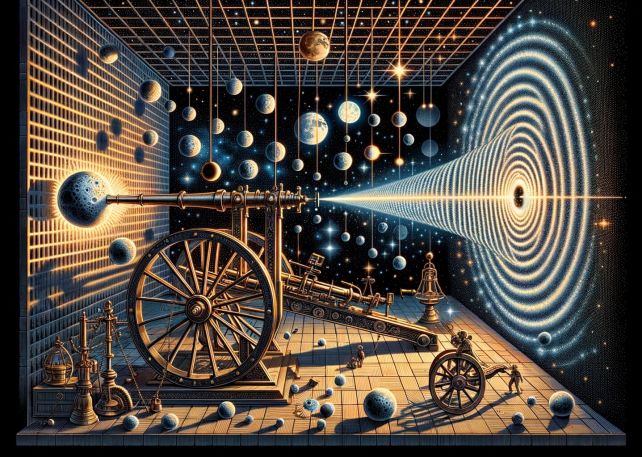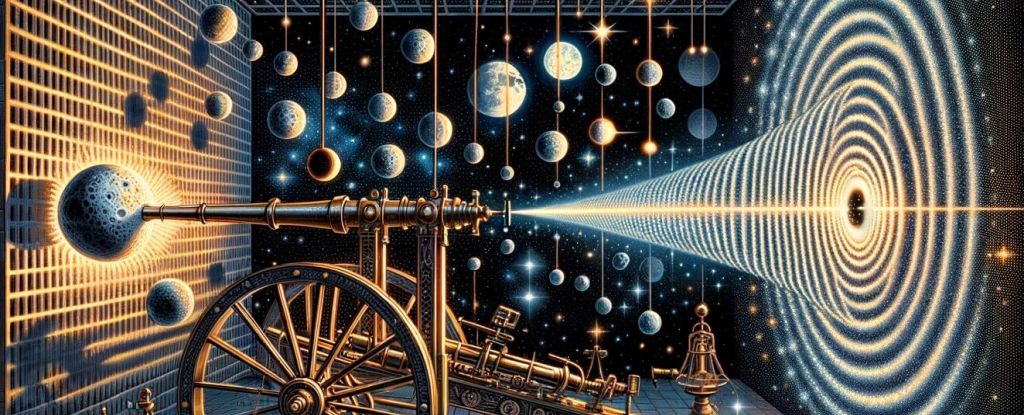Products You May Like
Some enmities are so powerful, they could never be resolved. Bette and Joan. Batman and the Joker. Hamilton and Burr.
It was starting to look like that list would include general relativity and quantum theory, two mathematical frameworks for describing the Universe that just cannot be made to fit together.
But in new paper, physicist Jonathan Oppenheim of University College London claims to have found a way to resolve their differences.
And it gets better – a second paper lays out a way to test it experimentally.
“Quantum theory and Einstein’s theory of general relativity are mathematically incompatible with each other, so it’s important to understand how this contradiction is resolved,” Oppenheim explains.
“Should space-time be quantized, or should we modify quantum theory, or is it something else entirely?”
The Universe doesn’t behave in a unified manner across scales, and we have different tools for exploring and describing it. General relativity is the theory that describes gravitational interactions in the large-scale physical Universe, based on the way gravity curves space-time.
It can be used to make predictions about the Universe; general relativity predicted gravitational waves, gravitational lensing, and some behaviors of black holes.
At much smaller scales – atomic and subatomic – gravity doesn’t work the way it does under relativity. A different set of rules is needed to describe the way matter behaves and interacts. This is quantum theory.
For decades, physicists have been trying to figure out how to make the two rulesets work together. The realms of relativity and quantum theory interact in the real world, but scientists haven’t been able to figure out how.

The current thought is that gravity can, somehow, be described using quantum theory, or quantized. This is behind theories such as string theory and quantum loop theory.
But in his paper, Oppenheim lays out a completely different alternative. What if space-time can’t be quantized, because it is ruled entirely by classical physics?
Imagine reality is your computer or phone screen. You can see the big picture clearly, but if you use a magnifier on the screen, you’ll see it’s composed of teeny tiny units.
Under quantum theory, this is the Universe. If you zoom in far enough, it’s made up of miniscule basic units, or quanta, like the pixels on your screen. If space-time isn’t quantum, it doesn’t matter how far you zoom in; it will always be smooth.
Under Oppenheim’s theory, however, space-time wouldn’t just be smooth, it would become sort of wobbly and unpredictable.
Here’s where it becomes testable. This wobbliness would result in fluctuations of measurable properties that are larger than the fluctuations predicted by quantum theory.
With the right experiment, physicists could look for those fluctuations.

“We have shown that if space-time doesn’t have a quantum nature, then there must be random fluctuations in the curvature of space-time which have a particular signature that can be verified experimentally,” says physicist Zach Weller-Davies of University College London.
“In both quantum gravity and classical gravity, space-time must be undergoing violent and random fluctuations all around us, but on a scale which we haven’t yet been able to detect. But if space-time is classical, the fluctuations have to be larger than a certain scale, and this scale can be determined by another experiment where we test how long we can put a heavy atom in superposition of being in two different locations.”
Now, the problem of relativity and quantum mechanics is a big one. Resolving it is going to require absolutely extraordinary evidence, and we’re very far from that.
And Oppenheim’s theory certainly has opposition from within the scientific community.
In fact, fellow physicists Carlo Rovelli and Geoff Penington feel so strongly that quantum theory can describe gravity that they have signed a bet against Oppenheim at 5,000:1 odds.
Carlo offered to give me 5000 coloured balls so I can play bazinga: https://t.co/teDCXmj9w4 and if he wins, I give him one red ball. But I don’t play bazinga, and he seems unexcited by my proposals: 50 ml of olive oil or wine? .00002 bitcoin? a packet of crisps? My home? 2/
— Jonathan Oppenheim (@postquantum) January 21, 2021
But even finding nothing in an experiment can tell us important somethings, so whichever way the experiment turns out, we can learn something interesting and valuable from it.
“Experiments to test the nature of space-time will take a large-scale effort, but they’re of huge importance from the perspective of understanding the fundamental laws of nature,” says physicist Sougato Bose of University College London, who was not involved in these papers.
“I believe these experiments are within reach – these things are difficult to predict, but perhaps we’ll know the answer within the next 20 years.”
Oppenheim’s theory has been published in Physical Review X. An experiment designed to test it has been described in Nature Communications.
